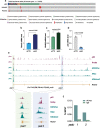NUAK2 and RCan2 participate in the p53 mutant pro-tumorigenic network
- PMID: 34348766
- PMCID: PMC8335924
- DOI: 10.1186/s13062-021-00296-5
NUAK2 and RCan2 participate in the p53 mutant pro-tumorigenic network
Abstract
Most inactivating mutations in TP53 gene generates neomorphic forms of p53 proteins that experimental evidence and clinical observations suggest to exert gain-of-function effects. While massive effort has been deployed in the dissection of wild type p53 transcriptional programme, p53 mutant pro-tumorigenic gene network is still largely elusive. To help dissecting the molecular basis of p53 mutant GOF, we performed an analysis of a fully annotated genomic and transcriptomic human pancreatic adenocarcinoma to select candidate players of p53 mutant network on the basis their differential expression between p53 mutant and p53 wild-type cohorts and their prognostic value. We identified NUAK2 and RCan2 whose p53 mutant GOF-dependent regulation was further validated in pancreatic cancer cellular model. Our data demonstrated that p53R270H can physically bind RCan2 gene locus in regulatory regions corresponding to the chromatin permissive areas where known binding partners of p53 mutant, such as p63 and Srebp, bind. Overall, starting from clinically relevant data and progressing into experimental validation, our work suggests NUAK2 and RCan2 as novel candidate players of the p53 mutant pro-tumorigenic network whose prognostic and therapeutic interest might attract future studies.
Keywords: Cancer prognosis; Metastasis; Tumour progression; Tumour suppression.
© 2021. The Author(s).
Conflict of interest statement
The authors declare that they have no competing interests.
Figures



Similar articles
-
Selective metabolic regulations by p53 mutant variants in pancreatic cancer.J Exp Clin Cancer Res. 2024 Nov 26;43(1):310. doi: 10.1186/s13046-024-03232-3. J Exp Clin Cancer Res. 2024. PMID: 39587609 Free PMC article.
-
p53 mutations define the chromatin landscape to confer drug tolerance in pancreatic cancer.Mol Oncol. 2022 Mar;16(6):1259-1271. doi: 10.1002/1878-0261.13161. Epub 2022 Feb 11. Mol Oncol. 2022. PMID: 34919788 Free PMC article.
-
Gain-of-function mutant p53 promotes the oncogenic potential of head and neck squamous cell carcinoma cells by targeting the transcription factors FOXO3a and FOXM1.Oncogene. 2018 Mar;37(10):1279-1292. doi: 10.1038/s41388-017-0032-z. Epub 2017 Dec 22. Oncogene. 2018. PMID: 29269868 Free PMC article.
-
Mutant p53-Associated Molecular Mechanisms of ROS Regulation in Cancer Cells.Biomolecules. 2020 Feb 26;10(3):361. doi: 10.3390/biom10030361. Biomolecules. 2020. PMID: 32111081 Free PMC article. Review.
-
Gain-of-Function Mutant p53: All the Roads Lead to Tumorigenesis.Int J Mol Sci. 2019 Dec 8;20(24):6197. doi: 10.3390/ijms20246197. Int J Mol Sci. 2019. PMID: 31817996 Free PMC article. Review.
Cited by
-
Alpha-actnin-4 (ACTN4) selectively affects the DNA double-strand breaks repair in non-small lung carcinoma cells.Biol Direct. 2022 Dec 7;17(1):40. doi: 10.1186/s13062-022-00354-6. Biol Direct. 2022. PMID: 36476259 Free PMC article.
-
Programmed Cell Death Pathways in Cholangiocarcinoma: Opportunities for Targeted Therapy.Cancers (Basel). 2023 Jul 15;15(14):3638. doi: 10.3390/cancers15143638. Cancers (Basel). 2023. PMID: 37509299 Free PMC article. Review.
-
p53-driven lipidome influences non-cell-autonomous lysophospholipids in pancreatic cancer.Biol Direct. 2022 Mar 8;17(1):6. doi: 10.1186/s13062-022-00319-9. Biol Direct. 2022. PMID: 35255936 Free PMC article.
-
Aged mesenchymal stem cells and inflammation: from pathology to potential therapeutic strategies.Biol Direct. 2023 Jul 18;18(1):40. doi: 10.1186/s13062-023-00394-6. Biol Direct. 2023. PMID: 37464416 Free PMC article. Review.
-
Total neoadjuvant therapy for the treatment of locally advanced rectal cancer: a systematic minireview.Biol Direct. 2022 Jun 13;17(1):16. doi: 10.1186/s13062-022-00329-7. Biol Direct. 2022. PMID: 35698084 Free PMC article. Review.
References
Publication types
MeSH terms
Substances
LinkOut - more resources
Full Text Sources
Molecular Biology Databases
Research Materials
Miscellaneous

